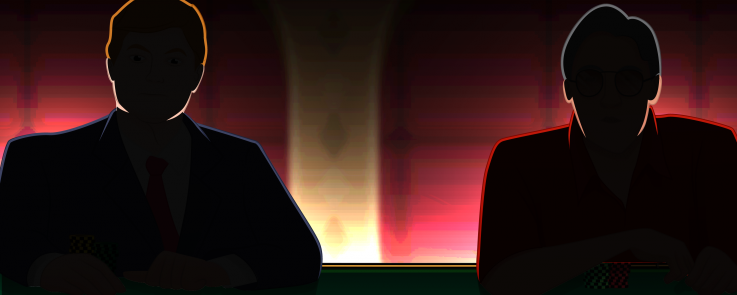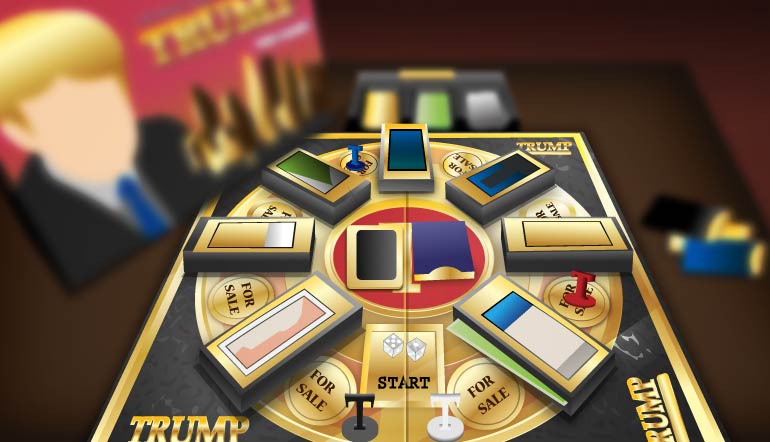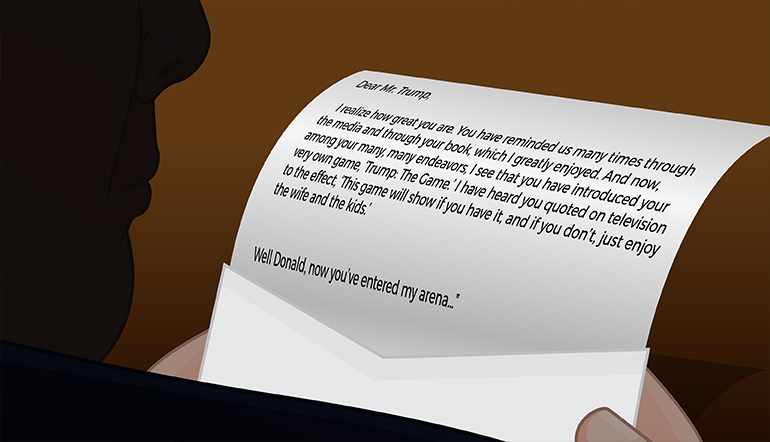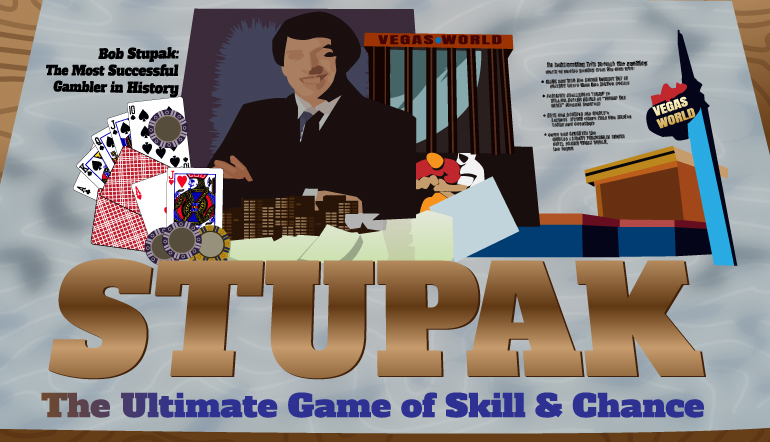One Million Dollars Says I Can Beat Donald Trump at His Own Game

By Anonymous
|
|
As President of the United States Donald Trump is expected to take on some tough adversaries, from the heads of other countries to special prosecutors in his own. But throughout Trump’s colorful and outrageous public life he has taken on plenty of challenges - in business, in his personal life, and even across the live tables at his casinos in Atlantic City. Sometimes he’d emerge the victor. Other times he’d lose. But occasionally, when Trump knew he didn’t stand a chance to win, he’d duck out. That’s exactly what he did when Las Vegas casino owner Bob Stupak came calling in 1989.
Bob Stupak was a classic Las Vegas story. The son of a professional gambler who ran a dice game in Pittsburgh for fifty years, the younger Stupak had a hustler’s heart. He made a fortune in the burgeoning coupon book industry in 1970s, mostly on the strength of his personality and salesmanship, selling a deal to both businesses and customers that neither likely needed. He parlayed his success into a small parcel of land north of the Las Vegas Strip that he transformed into Vegas World, a bargain-priced second-rate hotel and casino. But Stupak used his gifts for self promotion and hustling to draw outsized-attention to the under-sized property. From offering his own rules on blackjack (both dealer cards face up) to making a million dollar Super Bowl bet with another casino owner, to running for mayor of Las Vegas, Stupak knew how to get publicity for his Little Casino That Could.
As Vegas World grew throughout the 1980s, the gaming establishment began to take the upstart Stupak more seriously. When he built Vegas World in 1979 he had 100 rooms and grossed $15 million. By 1989 he had a thousand rooms and grossed $100 million a year. The slogan at Vegas World was “The Sky’s the Limit,” and Stupak put his money where his mouth was. His betting limits were $2,000, double the limit at the ritzy Caesar’s Palace on the Strip. And he was planning to literally reach into the sky with the construction of the 1,000-plus foot Stratosphere Tower.
But no matter how much success Bob Stupak had, he couldn’t seem to emerge from the shadow of another casino mogul on the East Coast, Donald Trump. Trump, too, was gifted at generating publicity for himself - and most importantly building a cult of personality around himself as a genius businessman with no equal. In 1989 Trump made Forbes’ list of the world’s billionaires for the first time, and they estimated his worth at $1.5 billion. While we now know that much of his wealth at that time came from borrowing heavily to purchase money-losing properties, at the time he looked like someone who had amassed a billion dollar fortune in less than four years. And though the following year his net worth would be estimated by Forbes at possibly zero, in 1989 he was still thought of as the country’s avatar of success, and a media darling with bestselling books, a football league, a number of properties in New York and casinos in Atlantic City with his name across the side in capital letters.
In February 1989 at a press conference at Trump Tower, Trump unveiled his latest business venture: a board game called “Trump: The Game.” The tagline for the game was “It’s not whether you win or lose, it’s whether you win!” The game would retail for $25 and Trump pledged his portion of the profits to go towards charities for AIDS research and cerebral palsy.

The game wasn’t designed by the casino mogul, but by game designer Jeffrey Breslow. Trump’s one requirement of the game was that he “didn't want a game based solely on chance. I wanted a game based on talent. And I wanted to teach people if they have business instincts. It's great if they can learn that from a game instead of having to go out and lose your shirt." Breslow and Milton Bradley did their best, creating a game that was similar to Monopoly, although much more complex, using a system of blind bidding for properties and relying less on the luck of the dice. As a consequence, the rulebook was more than 12 pages long.
When Bob Stupak heard about the game, he had an idea. He drew up a letter to Trump. The letter began: “Dear Mr. Trump, I realize how great you are. You have reminded us many times through the media and through your book, which I greatly enjoyed. And now, among your many, many endeavors, I see that you have introduced your very own game, ‘Trump: The Game.’ I have heard you quoted on television to the effect, ‘This game will show if you have it, and if you don’t, just enjoy the wife and the kids.’
Well Donald, now you’ve entered my arena…”
The letter went on to read in all capital letters: “ONE MILLION DOLLARS SAYS I CAN BEAT DONALD TRUMP AT ‘HIS OWN GAME.’”

Stupak took the letter and sent it to the New York Times, offering to take out a full page ad to run the letter in full. The Times declined. He then went to the Wall Street Journal, who also turned him down. Finally he convinced the New York Post to run his letter as a full page ad. He also took out a page in the Atlantic City press as well, just for good measure.
After Stupak’s challenge, many of his friends in Vegas said they didn’t think Trump would even respond. So Stupak, like a true gambler, offered them to bet. He got 2-1 against and took all comers, stacking up plenty of side action to go along with the publicity his challenge was generating. Those who bet against Stupak didn’t understand Donald Trump the way Bob Stupak did. Perhaps it was because the two men were kindred spirits - larger-than-life self-aggrandizing men who let the media and the public define them. Stupak would collect from his doubters when Trump issued a statement in response to media inquiries about the challenge, a response that doubled as a dig at Stupak. “Playing a man I don’t know and haven’t heard of for $1,000,000 is a no win situation,” Trump told reporters. “It’s always possible to lose, even for someone who’s used to winning.”
Stupak’s response? “Well if he doesn’t know me and hasn’t heard of me, he must have been living in Russia.” And he had a point. It was unlikely Trump didn’t know about Bob Stupak. Like Trump, Stupak put his name across the top of his hotel in big lights. He made his business more about himself and his personality than anything else. When Stupak was asked if his challenge was an attempt to ride on Trump’s coattails he showed just how much the two men were cut from the same cloth when he said “I’m not looking to ride on Donald Trump. I’m giving him an opportunity to ride on my reputation,” a Trumpian answer if there ever was one.
Not to be deterred, Stupak pressed on with his challenge. He produced his own board game called “Stupak: The Ultimate Game of Skill and Chance.” He offered Trump a new bet: Trump wouldn’t have to put up a penny, and Stupak would put up $250,000 and the winner of the game could decide which charity Stupak would give it to. Stupak chose Las Vegas disability services non profit Opportunity Village. “I read that things are a bit tight at your place,” Stupak wrote in reference to massive losses reported at Trump’s Atlantic City properties, “so I’ll put up all the money. Surely you can spare a few hours away from your lawyers for a friendly game when your favorite charity (or mine) will be the big winner.”

Again Trump rebuffed Stupak’s challenge, though this time it was a bit harder. The public clamored for Trump to accept. After all, he had nothing to lose and it would all go to charity. Opportunity Village sent a telegram to Trump asking him to please accept.
One issue at play beneath the surface of this gambit by Bob Stupak was that Donald Trump had been making statements about moving into Las Vegas and developing property there. “Donald says he wants to come to Las Vegas,” Stupak said at the time. “If he does, then he should come out and get involved in the community. I hope he accepts the challenge this time, because it’s for a worthwhile cause.”
Trump never responded, but Stupak had won plenty. He got his name in papers from coast to coast. He made himself look more outlandish and bold than his rival. He earned some respect from the Las Vegas community. And he had people talking about Vegas World and Bob Stupak once again.
Trump: The Game, meanwhile, was a flop. Milton Bradley had hoped to sell two million units in the first year. It sold only 800,000. People were reluctant to purchase a game from a real-life billionaire and line his pockets. So Milton Bradley re-cut the commercial and added in a voiceover declaring that Trump’s proceeds from the game were going to charity. It didn’t help. The truth was that the game was overly-complicated and not very fun. Why would people want to play Trump: The Game when they could play Monopoly?
Years later when talking about the challenge with his biographer, Las Vegas Review columnist John Smith, Stupak admitted that he never even read the rules of Trump: The Game. If he had, he’d have noticed that the game requires at least three players. It’s not even possible to play it heads-up. For all his carping about why he couldn’t accept Stupak’s challenge, Trump never even mentioned this important, disqualifying point. Perhaps Trump, too, didn’t even know how to play his own game.
Bob Stupak was a classic Las Vegas story. The son of a professional gambler who ran a dice game in Pittsburgh for fifty years, the younger Stupak had a hustler’s heart. He made a fortune in the burgeoning coupon book industry in 1970s, mostly on the strength of his personality and salesmanship, selling a deal to both businesses and customers that neither likely needed. He parlayed his success into a small parcel of land north of the Las Vegas Strip that he transformed into Vegas World, a bargain-priced second-rate hotel and casino. But Stupak used his gifts for self promotion and hustling to draw outsized-attention to the under-sized property. From offering his own rules on blackjack (both dealer cards face up) to making a million dollar Super Bowl bet with another casino owner, to running for mayor of Las Vegas, Stupak knew how to get publicity for his Little Casino That Could.
As Vegas World grew throughout the 1980s, the gaming establishment began to take the upstart Stupak more seriously. When he built Vegas World in 1979 he had 100 rooms and grossed $15 million. By 1989 he had a thousand rooms and grossed $100 million a year. The slogan at Vegas World was “The Sky’s the Limit,” and Stupak put his money where his mouth was. His betting limits were $2,000, double the limit at the ritzy Caesar’s Palace on the Strip. And he was planning to literally reach into the sky with the construction of the 1,000-plus foot Stratosphere Tower.
But no matter how much success Bob Stupak had, he couldn’t seem to emerge from the shadow of another casino mogul on the East Coast, Donald Trump. Trump, too, was gifted at generating publicity for himself - and most importantly building a cult of personality around himself as a genius businessman with no equal. In 1989 Trump made Forbes’ list of the world’s billionaires for the first time, and they estimated his worth at $1.5 billion. While we now know that much of his wealth at that time came from borrowing heavily to purchase money-losing properties, at the time he looked like someone who had amassed a billion dollar fortune in less than four years. And though the following year his net worth would be estimated by Forbes at possibly zero, in 1989 he was still thought of as the country’s avatar of success, and a media darling with bestselling books, a football league, a number of properties in New York and casinos in Atlantic City with his name across the side in capital letters.
In February 1989 at a press conference at Trump Tower, Trump unveiled his latest business venture: a board game called “Trump: The Game.” The tagline for the game was “It’s not whether you win or lose, it’s whether you win!” The game would retail for $25 and Trump pledged his portion of the profits to go towards charities for AIDS research and cerebral palsy.

The game wasn’t designed by the casino mogul, but by game designer Jeffrey Breslow. Trump’s one requirement of the game was that he “didn't want a game based solely on chance. I wanted a game based on talent. And I wanted to teach people if they have business instincts. It's great if they can learn that from a game instead of having to go out and lose your shirt." Breslow and Milton Bradley did their best, creating a game that was similar to Monopoly, although much more complex, using a system of blind bidding for properties and relying less on the luck of the dice. As a consequence, the rulebook was more than 12 pages long.
When Bob Stupak heard about the game, he had an idea. He drew up a letter to Trump. The letter began: “Dear Mr. Trump, I realize how great you are. You have reminded us many times through the media and through your book, which I greatly enjoyed. And now, among your many, many endeavors, I see that you have introduced your very own game, ‘Trump: The Game.’ I have heard you quoted on television to the effect, ‘This game will show if you have it, and if you don’t, just enjoy the wife and the kids.’
Well Donald, now you’ve entered my arena…”
The letter went on to read in all capital letters: “ONE MILLION DOLLARS SAYS I CAN BEAT DONALD TRUMP AT ‘HIS OWN GAME.’”

Stupak took the letter and sent it to the New York Times, offering to take out a full page ad to run the letter in full. The Times declined. He then went to the Wall Street Journal, who also turned him down. Finally he convinced the New York Post to run his letter as a full page ad. He also took out a page in the Atlantic City press as well, just for good measure.
After Stupak’s challenge, many of his friends in Vegas said they didn’t think Trump would even respond. So Stupak, like a true gambler, offered them to bet. He got 2-1 against and took all comers, stacking up plenty of side action to go along with the publicity his challenge was generating. Those who bet against Stupak didn’t understand Donald Trump the way Bob Stupak did. Perhaps it was because the two men were kindred spirits - larger-than-life self-aggrandizing men who let the media and the public define them. Stupak would collect from his doubters when Trump issued a statement in response to media inquiries about the challenge, a response that doubled as a dig at Stupak. “Playing a man I don’t know and haven’t heard of for $1,000,000 is a no win situation,” Trump told reporters. “It’s always possible to lose, even for someone who’s used to winning.”
Stupak’s response? “Well if he doesn’t know me and hasn’t heard of me, he must have been living in Russia.” And he had a point. It was unlikely Trump didn’t know about Bob Stupak. Like Trump, Stupak put his name across the top of his hotel in big lights. He made his business more about himself and his personality than anything else. When Stupak was asked if his challenge was an attempt to ride on Trump’s coattails he showed just how much the two men were cut from the same cloth when he said “I’m not looking to ride on Donald Trump. I’m giving him an opportunity to ride on my reputation,” a Trumpian answer if there ever was one.
Not to be deterred, Stupak pressed on with his challenge. He produced his own board game called “Stupak: The Ultimate Game of Skill and Chance.” He offered Trump a new bet: Trump wouldn’t have to put up a penny, and Stupak would put up $250,000 and the winner of the game could decide which charity Stupak would give it to. Stupak chose Las Vegas disability services non profit Opportunity Village. “I read that things are a bit tight at your place,” Stupak wrote in reference to massive losses reported at Trump’s Atlantic City properties, “so I’ll put up all the money. Surely you can spare a few hours away from your lawyers for a friendly game when your favorite charity (or mine) will be the big winner.”

Again Trump rebuffed Stupak’s challenge, though this time it was a bit harder. The public clamored for Trump to accept. After all, he had nothing to lose and it would all go to charity. Opportunity Village sent a telegram to Trump asking him to please accept.
One issue at play beneath the surface of this gambit by Bob Stupak was that Donald Trump had been making statements about moving into Las Vegas and developing property there. “Donald says he wants to come to Las Vegas,” Stupak said at the time. “If he does, then he should come out and get involved in the community. I hope he accepts the challenge this time, because it’s for a worthwhile cause.”
Trump never responded, but Stupak had won plenty. He got his name in papers from coast to coast. He made himself look more outlandish and bold than his rival. He earned some respect from the Las Vegas community. And he had people talking about Vegas World and Bob Stupak once again.
Trump: The Game, meanwhile, was a flop. Milton Bradley had hoped to sell two million units in the first year. It sold only 800,000. People were reluctant to purchase a game from a real-life billionaire and line his pockets. So Milton Bradley re-cut the commercial and added in a voiceover declaring that Trump’s proceeds from the game were going to charity. It didn’t help. The truth was that the game was overly-complicated and not very fun. Why would people want to play Trump: The Game when they could play Monopoly?
Years later when talking about the challenge with his biographer, Las Vegas Review columnist John Smith, Stupak admitted that he never even read the rules of Trump: The Game. If he had, he’d have noticed that the game requires at least three players. It’s not even possible to play it heads-up. For all his carping about why he couldn’t accept Stupak’s challenge, Trump never even mentioned this important, disqualifying point. Perhaps Trump, too, didn’t even know how to play his own game.


